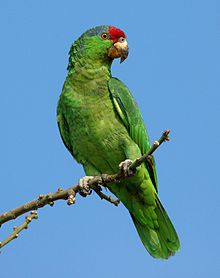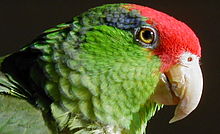Red-crowned amazon
| Red-crowned amazon | |
|---|---|

| |
| Scientific classification | |
| Domain: | Eukaryota |
| Kingdom: | Animalia |
| Phylum: | Chordata |
| Class: | Aves |
| Order: | Psittaciformes |
| Family: | Psittacidae |
| Genus: | Amazona |
| Species: | A. viridigenalis
|
| Binomial name | |
| Amazona viridigenalis (Cassin, 1853)
| |

| |
The red-crowned amazon (Amazona viridigenalis), also known as the red-crowned parrot, green-cheeked amazon or Mexican red-headed parrot, is an endangered amazon parrot native to northeastern Mexico and possibly southern Texas in the United States.[3][4] A 1994 study estimated wild populations of between 2,000 and 4,300 mature individuals; the IUCN Red List considers it a globally endangered species with a decreasing population.[1] The main threats to the native bird's survival are the illegal export of trapped birds from Mexico to the United States for the pet trade and the destruction of their natural habitat, the lowland forests of northeastern Mexico.[5]
Description[edit]


Their appearance is generally green with the most notable features being a bright red forehead and crown, dark blue streak behind the eyes, and light green cheeks. It is not uncommon for red-crowned amazons to have splashes of red and blue under their wings and have light yellow-tipped tails.[6] They have a white eye-ring which brings out their eyes. Their iris color can range from a bright yellow to a deep red, although juveniles' eyes are gray until maturity. Red-crowned amazons usually have horn colored beaks and ceres but these can sometimes have black highlights. Their legs are beige or gray. They are approximately 11–13 inches (28–33 cm) in length from the beak to the tip of the tail feathers with a wingspan of 15–16 inches (38–41 cm). Most Amazon parrots are not sexually dimorphic (the exceptions being the White-fronted Amazona albifrons, Yellow-lored Amazona xantholora, and Blue-fronted Amazona aestiva) so the only true way to identify gender is by genetic testing. Their average weight is 270 grams (9.5 oz).[7]
Range[edit]
Their natural range is across the lowlands of northeastern Mexico, and possibly the southern tip of Texas.[4] Red-crowned amazons are a resident (non-migratory) species in their native range, but they can wander outside of their breeding range to follow a food source. Feral birds have bred in urban communities of southern California, southern Florida and the island of Oahu in Hawaii.
On June 4, 2019, the Corpus Christi Ecological Services Field Office of the US Fish & Wildlife Service announced to the public that the USFWS considers the red-crowned parrot native to Texas in the Rio Grande Valley.[4] However, because parrots were not mentioned in the Migratory Bird Treaty Act of 1918, birds in the Texas portion of their range are not entitled to USFWS protection, and must rely on enacted state and local laws.[4] The USFWS estimated that there are roughly 700 wild red-crowned parrots in the Rio Grande Valley of Texas in 2019, and historical records place parrots in South Texas as early as 1885. The numbers of wild parrots in the United States now rivals populations in Mexico, due to their adaptation to urban life.[5] However, the IUCN and other resources consider the bird to be non-native to all parts of the United States, including southern Texas.[1][8] NatureServe considers the species to be "Imperiled" in Texas.[9][10]
Feral parrots[edit]
Populations of feral parrots exist in cities such as the Los Angeles metropolitan area in California, US, especially the San Gabriel Valley. Populations also exist in the San Diego area. Captured birds there escaped and became part of the urban ecosystem, starting in about the 1960s.[11] The California Parrot Project says that red-crowned amazons are among the thirteen species of parrots with naturalized populations in California, including six in the genus Amazona.[12] Los Angeles has been called a sanctuary for this endangered species, with a population of around 3,000 that is estimated to meet or exceed the remaining wild population in Mexico.[13][14] Area residents say that although the birds annoy with their loud calls, they also inspire local pride and identity.[14]
Behavior[edit]
They gather in large flocks being noisiest in the morning and evening. The characteristic screeching heard of these birds usually occurs when they travel in a large flock to a new feeding area. Their diet consists of seeds, fruits, flowers and nectar. Red-crowned amazons nest in tree cavities, like most other parrots. Amazons are one of the easiest parrots to read the behavior of, as their eye color shows their pinning exceptionally well. Red-crowned amazons pin their eyes when they are excited, either positively or negatively, about something in their environment. It is easy to make out the dilations of the pupil against the bright iris. This pinning, combined with different behavioral signs, can let a fellow parrot or an owner know how the parrot is feeling. An angry parrot may fan its tail feathers while a content, affectionate parrot may purr, or bend their head down to be scratched.[15]
Reproduction[edit]
Red-crowned amazon parrots reach sexual maturity at about five years old. It takes the female approximately 28 days to incubate her eggs, at an average of four eggs per clutch.[16] Fledging begins at nine weeks old. In the wild, these parrots mate for life and find tree cavities near other members of their flock, creating a breeding group known as a colony.[17] They will return to the same cavity every year to raise chicks unless that cavity was previously poached or they did not have reproductive success there for a different reason.
Aviculture[edit]
These parrots are often kept as pets and can be very affectionate and playful when given the attention they need from their owners. Although some are excellent talkers and copy voices, they are best at mimicking sounds that stand out to them, such as the microwave, telephone or other pets. Many owners report a streak of mischief due to their heightened curiosity. Red-crowned amazons can live 50+ years in captivity, with some extending over 70 years old if properly cared for.[18]
Common challenges associated with owning this type of parrot includes being able to provide enough exercise for it and convincing it to eat a varied, healthy diet, close to the diet it would have in the wild. Amazons are known for becoming sedentary if not provided enough stimuli, and this can lead to health issues, such as obesity. These birds are not regarded as overly sensitive and are actually one of the hardier large species to own as a pet because common stressors for other companion parrot species are coped with better and neurotic behaviors due to stress or depression, such as feather plucking, are infrequent when compared to other species. Another challenge some owners face is the hormonal bluffing during the breeding season (spring) for adolescents that causes some parrots, especially males, to be more prone to nipping their owners, biting anyone who is not their favorite person and screaming. These hormonal outbursts decrease with age.[19]
References[edit]
- ^ a b c BirdLife International (2021). "Amazona viridigenalis". IUCN Red List of Threatened Species. 2021: e.T22686259A152441187. Retrieved 21 November 2022.
- ^ "Appendices | CITES". cites.org. Retrieved 2022-01-14.
- ^ Shackelford, C., and C. Hanks. 2016. Red-crowned parrot conservation in Texas—Background and roost survey results for 2016: Texas Parks and Wildlife Department, Austin, Texas.
- ^ a b c d Moore, Richard (4 June 2019). "Parrot Protection". KVEO-TV. Retrieved 27 December 2020.
- ^ a b "Red-crowned Parrot". American Bird Conservancy. Retrieved 25 February 2018.
- ^ "Red-crowned Parrot". Audubon.org. Retrieved 25 February 2018.
- ^ "Green-cheeked Amazon". Parrots.org. Retrieved 25 February 2018.
- ^ "Red-crowned Parrot, Amazona viridigenalis (Cassin 1853)". www.californiaparrotproject.org. The California Parrot Project. Retrieved 27 December 2020.
- ^ "TPWD Wildlife Diversity, TXNDD Tracked Animals" (PDF). tpwd.texas.gov. Texas Parks & Wildlife. Retrieved 27 December 2020.
- ^ "NatureServe Explorer 2.0". explorer.natureserve.org. Retrieved 31 March 2022.
- ^ Garrett, Kimball (2010). "Red-Crowned Parrot". The California Parrot Project. Retrieved 2020-12-29.
- ^ Garrett, Kimball (2010). "Identification Guide". The California Parrot Project. Retrieved 2020-12-29.
- ^ Heise, Ursula K. (2018-06-08). "Wild parrots fill the soundscape in Los Angeles". Elemental Report. UCLA. Retrieved 2020-12-29.
- ^ a b Paskin, Julia (2018-07-10). "Pasadena's Screaming Parrots Are Super Annoying But May Save Their Species From Extinction". LAist. Southern California Public Radio. Retrieved 2020-12-29.
- ^ Saydak, Dennis. "Understanding Amazon Behavior". The Amazona Society. Retrieved 25 February 2018.
- ^ "Red-crowned Amazon". Bird Guide. Retrieved 25 February 2018.
- ^ "Green-cheeked Amazon". World Parrot Trust. Retrieved 25 February 2018.
- ^ "Green-cheeked Amazon (Amazona viridigenalis) Parrot Encyclopedia". World Parrot Trust. Retrieved 27 December 2020.
- ^ Kalhagen, Alyson. "Green-cheeked Amazon Parrots". The Spruce. Retrieved 25 February 2018.
- "National Geographic" Field Guide to the Birds of North America ISBN 0-7922-6877-6
- Handbook of the Birds of the World Vol 4, Josep del Hoyo editor, ISBN 84-87334-22-9
- "National Audubon Society" The Sibley Guide to Birds, by David Allen Sibley, ISBN 0-679-45122-6

